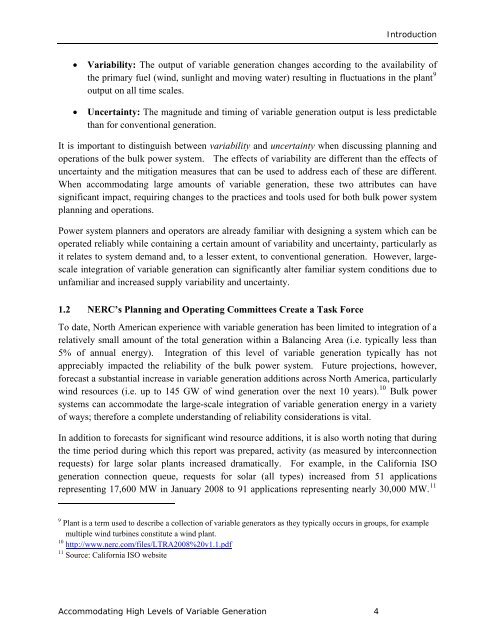Accommodating High Levels of Variable Generation - NERC
Accommodating High Levels of Variable Generation - NERC
Accommodating High Levels of Variable Generation - NERC
You also want an ePaper? Increase the reach of your titles
YUMPU automatically turns print PDFs into web optimized ePapers that Google loves.
Introduction<br />
• Variability: The output <strong>of</strong> variable generation changes according to the availability <strong>of</strong><br />
the primary fuel (wind, sunlight and moving water) resulting in fluctuations in the plant 9<br />
output on all time scales.<br />
• Uncertainty: The magnitude and timing <strong>of</strong> variable generation output is less predictable<br />
than for conventional generation.<br />
It is important to distinguish between variability and uncertainty when discussing planning and<br />
operations <strong>of</strong> the bulk power system. The effects <strong>of</strong> variability are different than the effects <strong>of</strong><br />
uncertainty and the mitigation measures that can be used to address each <strong>of</strong> these are different.<br />
When accommodating large amounts <strong>of</strong> variable generation, these two attributes can have<br />
significant impact, requiring changes to the practices and tools used for both bulk power system<br />
planning and operations.<br />
Power system planners and operators are already familiar with designing a system which can be<br />
operated reliably while containing a certain amount <strong>of</strong> variability and uncertainty, particularly as<br />
it relates to system demand and, to a lesser extent, to conventional generation. However, largescale<br />
integration <strong>of</strong> variable generation can significantly alter familiar system conditions due to<br />
unfamiliar and increased supply variability and uncertainty.<br />
1.2 <strong>NERC</strong>’s Planning and Operating Committees Create a Task Force<br />
To date, North American experience with variable generation has been limited to integration <strong>of</strong> a<br />
relatively small amount <strong>of</strong> the total generation within a Balancing Area (i.e. typically less than<br />
5% <strong>of</strong> annual energy). Integration <strong>of</strong> this level <strong>of</strong> variable generation typically has not<br />
appreciably impacted the reliability <strong>of</strong> the bulk power system. Future projections, however,<br />
forecast a substantial increase in variable generation additions across North America, particularly<br />
wind resources (i.e. up to 145 GW <strong>of</strong> wind generation over the next 10 years). 10 Bulk power<br />
systems can accommodate the large-scale integration <strong>of</strong> variable generation energy in a variety<br />
<strong>of</strong> ways; therefore a complete understanding <strong>of</strong> reliability considerations is vital.<br />
In addition to forecasts for significant wind resource additions, it is also worth noting that during<br />
the time period during which this report was prepared, activity (as measured by interconnection<br />
requests) for large solar plants increased dramatically. For example, in the California ISO<br />
generation connection queue, requests for solar (all types) increased from 51 applications<br />
representing 17,600 MW in January 2008 to 91 applications representing nearly 30,000 MW. 11<br />
9 Plant is a term used to describe a collection <strong>of</strong> variable generators as they typically occurs in groups, for example<br />
multiple wind turbines constitute a wind plant.<br />
10 http://www.nerc.com/files/LTRA2008%20v1.1.pdf<br />
11 Source: California ISO website<br />
<strong>Accommodating</strong> <strong>High</strong> <strong>Levels</strong> <strong>of</strong> <strong>Variable</strong> <strong>Generation</strong> 4
















